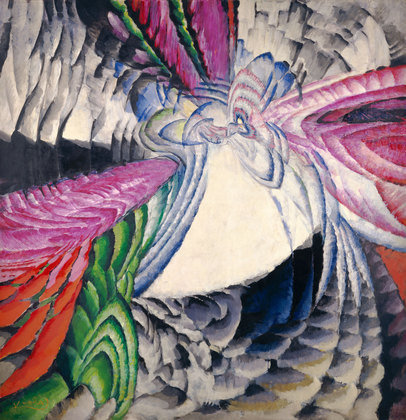Inventing Abstraction, 1910-1925
dal 17/12/2012 al 14/4/2013
Segnalato da
Vasily Kandinsky
Frantisek Kupka
Francis Picabia
Robert Delaunay
Pablo Picasso
Hans Arp
Fernand Leger
El Lissitzky
Kazimir Malevich
Piet Mondrian
Katarzyna Kobro
Wladyslaw Strzeminski
Guillaume Apollinaire
Rudolf von Laban
Arnold Schoenberg
Leah Dickerman
Masha Chlenova
17/12/2012
Inventing Abstraction, 1910-1925
The Museum of Modern Art - MoMA, New York
Commemorating the centennial of the moment at which a series of artists 'invented' abstraction, the exhibition is a sweeping survey of more than 400 artworks in a broad range of mediums -including paintings, drawings, prints, books, sculptures, films, photographs, recordings, and dance pieces- that represent a radical moment when the rules of art making were fundamentally transformed. A key premise of the show is abstraction's role as a cross-media practice from the start.

Inventing Abstraction, 1910–1925, on view at MoMA from
December 23, 2012, to April 15, 2013, explores the advent of abstraction as both a historical idea
and an emergent artistic practice. Commemorating the centennial of the moment at which a series
of artists “invented” abstraction, the exhibition is a sweeping survey of more than 400 artworks in
a broad range of mediums—including paintings, drawings, prints, books, sculptures, films,
photographs, recordings, and dance pieces—that represent a radical moment when the rules of art
making were fundamentally transformed. Half of the works in the exhibition, many of which have
rarely been seen in the United States, come from major international public and private collectors.
The exhibition is organized by Leah Dickerman, Curator, with Masha Chlenova, Curatorial
Assistant, Department of Painting and Sculpture, The Museum of Modern Art.
A key premise of the exhibition is abstraction’s role as a cross-media practice from the
start. This notion is illustrated through an exploration of the productive relationships between
artists, composers, dancers, and poets in establishing a new modern language for the arts.
Inventing Abstraction brings together works from a wide range of artistic mediums to draw a rich
portrait of the watershed moment in which traditional art was wholly reinvented.
Roughly one hundred years ago, a series of rapid shifts took place in the cultural sphere
that in the end amounted to the greatest rewriting of the rules of artistic production since the
Renaissance. Invented not just once, but by different artists in different locales with different
philosophical foundations, abstraction was quickly embraced by a post-Cubist generation of artists
as the language of the modern.
One of the first pictures in the exhibition, Woman with a Mandolin, made by Pablo Picasso
(Spanish, 1881–1973) in 1910, shows how he approached the brink of abstraction before turning
away. Beginning in December 1911 and across the course of 1912, a handful of artists, including
Vasily Kandinsky (Russian, 1886–1944), Robert Delaunay (French, 1885–1941), and Frantisek
Kupka (Czech, 1871–1957), presented the first abstract works in public exhibition. Inventing
Abstraction surveys the early history of abstraction from this pioneering moment through the mid-
1920s, when it was broadly embraced by the avant-garde.
The exhibition takes a transnational perspective, and includes work by artists from across
Eastern and Western Europe and the United States, such as Hans Arp (German/French, 1886–
1966), Fernand Léger (French, 1881–1955), El Lissitzky (Russian, 1890–1941), Kazimir Malevich
(Russian, 1879–1935), Piet Mondrian (Dutch, 1872–1944), and many others.
From the start, abstraction was an international phenomenon, with ideas, images, and
people traveling across borders through a new modern media and exhibition culture. Its pioneers
were far more closely linked than is generally known. Highlights in Inventing Abstraction include
Kandinsky’s Composition V, his most ambitious early abstract work; an important sequence of
Mondrian paintings that traces the development of his work from his famous Tree pictures of 1912
to a group of superb early Neo-Plastic paintings; works by Malevich documented in his display at
the landmark “0.10” exhibition held in Petrograd in 1915; a group of early rare works by avantgarde artists Katarzyna Kobro (Polish, 1898–1951) and Władysław Strzemiński (Polish, 1893–
1952), calligramme poems by Guillaume Apollinaire (French, 1880–1918), dance notations by
Rudolf von Laban (Hungarian, 1879–1958) and musical scores by Arnold Schoenberg (Austrian,
1874–1951).
The exhibition is made possible by Hanjin Shipping.
Major support is provided by the Anna-Maria and Stephen Kellen Foundation and by Marie-Josée and Henry Kravis.
This exhibition is supported by an indemnity from the Federal Council on the Arts and the Humanities.
The accompanying seminars are made possible by MoMA’s Wallis Annenberg Fund for Innovation in Contemporary Art through the Annenberg Foundation.
Image: František Kupka. Localization of Graphic Motifs II. 1912–13. Oil on canvas, 78 3/4 x 76 3/8" (200 x 194 cm), frame: 78 3/4 x 76 3/8" (200 x 194 cm). National Gallery of Art, Washington, D.C., Ailsa Mellon Bruce Fund and Gift of Jan and Meda Mladek. Image courtesy of the National Gallery of Art, Washington. © 2012 Artists Rights Society (ARS), New York/ADAGP, Paris
Press Contacts:
Brien McDaniel, 212-708-9747 or brien_mcdaniel@moma.org
Margaret Doyle, 212-408-6400 or margaret_doyle@moma.org
Press Preview: Tuesday, December 18, 10:00 a.m.–12:00 p.m.
The Museum of Modern Art MoMA
11 West 53 Street, New York, NY 10019
Hours: Wednesday through Monday, 10:30 a.m.–5:30 p.m. Friday, 10:30 a.m.–8:00 p.m. Closed Tuesday.
Museum Admission: $25 adults; $18 seniors, 65 years and over with I.D.; $14 full-time students with current I.D. Free, members and children 16 and under.



